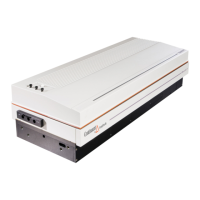Chapter II – System Operation
2-17
C
996-0255 rev. b
When this command is sent to the CU601 it sends back the “CU601C
status” in a 10 byte ASCII string followed by a carriage return. The status
byte is returned in the following format:
bbbbbbbbbb+CR+ LF = 10 bytes total
||||||||||_____________SHUTTER 0=CLOSED, 1=OPEN
|||||||||______________EOC 4 0=NOT CHARGED,1=CHARGED
||||||||_______________EOC 3 0=NOT CHARGED,1=CHARGED
|||||||________________EOC 2 0=NOT CHARGED,1=CHARGED
||||||_________________EOC 10=NOT CHARGED, 1=CHARGED
|||||__________________H GEN#2 CCW 0=NOT LIMIT,1=LIMIT
||||___________________H GEN#2 CW 0=NOT LIMIT,1=LIMIT
|||____________________H GEN#1 CCW 0=NOT LIMIT,1=LIMIT
||_____________________H GEN#1 CW 0=NOT LIMIT,1=LIMIT
|______________________Q-SWITCH 0=NOT ACTIVE 1=ACTIVE
b) RS232 specification/baud rate
The specifications for the RS232 channel are:
[xxxxx],N,8,1
| | |
|____ 1 STOP BIT
| |
|______ 8 DATA BITS
|
|________ NO PARITY
|_____________BAUD RATE SELECTABLE FROM:
110
150
300
600
1200
2400
4800
9600 (DEFAULT)
19200
c) RS232 signals
The RS232 connector on the front panel is a D25 female connector. The
following signals that are important for RS232 control are listed below:
RS232 pin Pin Description
2 TxD (transmit data)
3 RxD (receive data)
4 RTS (request to send)
5 CTS (clear to send)
7 SIGNAL COMMON
A typical interface cable for RS232 interface between a PC or equivalent
and the CU601C is as follows:

